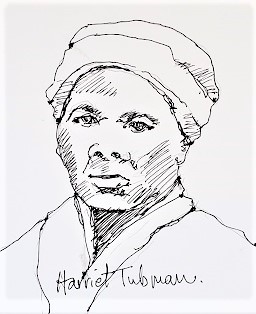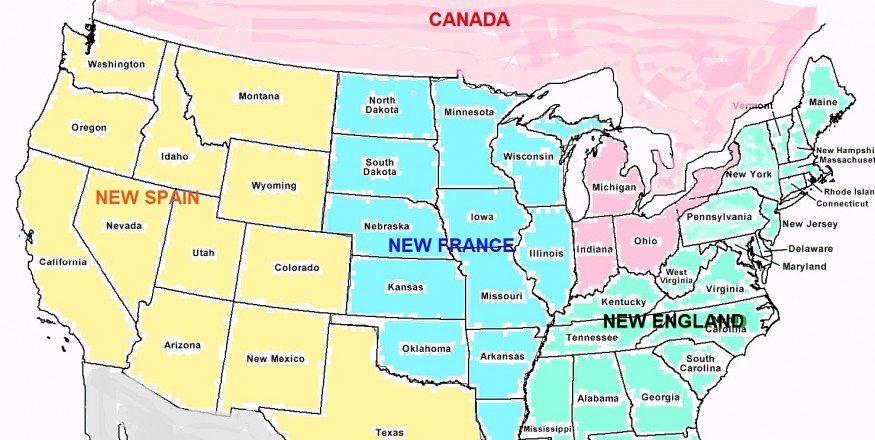 x
x
Part 2: New France. Abraham Barbury
JASON: I have travelled today to meet with Abraham Barbury in his studio in Chicago, Illinois.
As he rises to greet me, he unfolds his six-foot, still slim frame. He is looking at me with the watery sad eyes of an 80 year old black man who has lived a lot and seen a lot. His wiry white hair is in contrast to his wrinkled, dark skin. He is obviously of mixed race. So maybe I should start there. I want to know a bit about his ancestors on both sides – his father’s side, and his mother’s side.
ABRAHAM: “So, on my father’s side I can trace his family for six generations all the way back to the early 1800s. They were slaves of course, and the early generations lived in various places, various plantations I should say, but always in the state of North Carolina, in the Charlotte area. It is not as difficult to trace as you might think because most slave owners running a farm or business kept good records of their accounts. Yes, good records of their “assets” they would say.
My father’s grandfather, also an Abraham, left North Carolina in 1849 and settled in Arkansas. I should say he fled late at night, escaping all on his own, slipping away from his plantation south of Charlotte. He was on foot, travelling mostly at night and hiding during the daytime. It was a dangerous journey over some weeks. Dangerous because there were armed bounty hunters that would get a good reward for capturing an escaped slave. And if he survived, he would be returned to his owner, and his life would be an even greater hell than before.
There were some sympathetic people that gave shelter and food at “stations” along what was called the “Underground Railroad”. There were several routes heading west to the Mississippi and some that were even longer that went to the north all the way to Canada. You see France, and therefore New France, had abolished slavery years before in 1848 and if you could get across the Mississippi to Arkansas, to New France, you were a free man. The Underground Railroad had been running even longer to Canada since they abolished slavery in 1834. So, the Railroad provided food and safety as well as the routing for each night’s travel. They knew the best spots to cross the river; places where the river curved to the east and the current would take you to the western shore. You would cling or be tied to anything that would float, and pray for the best. If you survived the journey, you were a free man. Penniless and without friends or family, but a free man. Some travelled onward to New Spain and Mexico since they had abolished slavery in 1839. But you still needed to be careful. There were bounty hunters operating in these lands that would kidnap people they thought to be escaped slaves and return them to New England. In some cases they captured free blacks they had mistaken for escaped slaves. You had to be careful and find people you could trust.374Please respect copyright.PENANAntxm4t47wr
Then there was the story of Harriet Tubman. She was born on a plantation in Maryland to two enslaved parents and was given the name Aramite Ross by the plantation owner. She worked for her owner for some twenty odd years and was beaten many times before she finally escaped. She left her husband John Tubman behind and managed to live safely in hiding using assumed identities for years.
With her knowledge of the swampy areas around her native Maryland she began to escort other escaped slaves north to Pennsylvania. This was her initiation as a conductor on the Underground Railroad. When the Fugitive Slave Act of 1850 went into effect it became extremely dangerous even in the northern states since slaves could be recaptured and returned to owners for a bounty. The Underground Railroad then extended its routes all the way to Ontario in Canada where slavery had been abolished. Over this time, she is reported to have conducted some thirteen missions northward and guided over seventy slaves to freedom. She was known to pack a revolver that was used to discourage her charges from losing nerve and turning back to the plantation. She used it to enforce her warning to “either go forward or die” since she could not risk her group being discovered by those searching for them.
Then, when the Civil War broke out, she decided she could help her people even more by joining the Union forces. She served initially as a nurse and then as a scout or guide because of her knowledge of the terrain around the southern plantation lands. Her greatest achievement was as a guide for the famous Combahee River Raid where Union soldiers freed over seven hundred men, women, and children from enslavement in South Carolina.
The risks for escaped slaves were great but you see at the time, it did not look like New England would ever abolish slavery as other countries had done. It was too much a part of their prosperity in the south, and in fact, it took a Civil War to finally achieve in 1865, more than thirty years after the other countries.
You know, I would not be alive and telling you these stories if my great, great, grandfather had not made the risky journey to freedom. If he had stayed on the plantation in North Carolina he would likely have died there, either of old age, or worse. But in any event, slaves were not considered human and had no rights, so consequently he could not marry or have children – so I can be sure I would not exist except for his courage and the Underground Railroad””.
JASON: “” In Arkansas he was a free man, but without anything to help him make a fresh start. But perhaps it was not all bleak. I believe there were some sympathetic organizations in New France, several churches and such, plus there was a very broad network of fellow freed men who helped each other find places to stay and work””.
ABRAHAM: “” Yes there was some help to get settled. They were willing to do anything, and they were well-trained farmhands and hard workers. So, the obvious place was on farms where the owner could provide shelter, food, and . . . pay for work!
You know it was not a one-way passage westward across the Mississippi. In fact, there was migration in both directions, west and east. You see, in New France, there had been some slaves and slave owners just as there were east of the Mississippi. But after our abolition laws here in 1848 many of the slave owners in New France, and even more of what I call slavery sympathizers, migrated to the southeast states of New England where slavery continued to, shall I say, thrive.
And thrive it did, partly for economic reasons since plantation and factory owners could prosper with cheap labour, but also the supporters thought of Blacks as lesser beings, much like the animals they kept . . . . like horses that needed to be fed, but could do useful work for them. It was their tradition. Remember, the first slaves were delivered to the New England shore some 250 years before. So many generations had an ingrained, and inferior, view of my fellow Blacks””.
JASON: “”Some thirty years of dangerous migration westward across the Mississippi. No one is sure how many made the journey. There were no written records and all communication was verbal, and sometimes in special coded words to avoid detection by the authorities. It is estimated that 100,000 or more slaves escaped to freedom during this period – and there are no estimates of how many may have perished on the journey or following capture.
That sounds like a lot of people freed by the Underground Railroad. But it is not compared to the total number of slaves in the country at that time – some five million. Compared to the total population of 30 million at the time that meant that one in six people were slaves in this country
But with the abolition of slavery in New England in 1865 and the conclusion of the Civil War everything must have changed for the slaves that remained behind"".
ABRAHAM: ""Yes it did change, but for many not for the better. At the time there were more than four million slaves in the southern states. That was a lot to absorb into society. And the southern society was not ready willingly to do so. Living conditions for many freed slaves were worse than before. There was disease, starvation, and lynchings; but at least the beatings were stopped. In place of the oppression of slavery new rules called Jim Crow Laws were enacted. These are the laws of segregation of whites and blacks - separate schools, restaurants, drinking fountains that lasted one hundred years until the civil rights movement of the 1960s. Who was this Jim Crow we still hear about? He was a white man. A minstrel 30 years before the Civil War who was popular for his stage name Jim Crow when he did blackface impressions of simpleton negroes. So popular that the term Jim Crow was used as a derogatory term for any and all black people at the time and well after. So you were a fortunate black man if you escaped from New England; both before, and after, the official end of slavery””.
JASON: “”But it was not the first time for such mass migration of outcasts westward across the Mississippi””.
ABRAHAM: “” No, in the period 1830 to 1850, Andrew Jackson’s New England government, seeking more land for their own kind, decided to push the Indian tribes out. This was contrary to the ruling made by the New England Supreme Court just months before that upheld the Native tribe’s right to their treaty lands. Treaty lands that had been granted to them decades before by the same New England government. Jackson, the seventh president of New England, was fiercely in favour of slavery. He knew that his southern states had prospered by it, and they wanted more land for their expanding cotton plantations. Jackson’s decision was made even more popular, and urgent, by the discovery of gold in Georgia. The tribes, the Cherokee, Seminoles and others, were ordered by the government to move to the lands west of the Mississippi. This is what most of them did, or tried to do and many died along the way. Their experience was well documented in the famous book The Trail of Tears. But many resisted, in some cases entire tribes, and those resisters were exterminated . . . there is no better word for it, that is what was done.
Therefore, it was a good time for some, and not so good for others. It depended on your point of view, but mostly on the colour of your skin””.
JASON: The population of New France had grown to some eight million by the late 1800s. This was largely due to immigration from New England. In some cases white settlers seeking a new life, and in other cases Blacks and Indians fleeing persecution and seeking a free and tolerant land.
ABRAHAM: “”I still have family in Arkansas, but my father moved here to Chicago, and I was born here and have lived all my eighty years here in the south-side. I met my wife here in Chicago, at a church social. Now, her story is a little different from mine. Her family lived in Kansas City, and then moved to the Chicago area. They are French, and if you tried, I expect you could trace her ancestors all the way back to some early settlers from France. My wife had a fine career as an academic at Northwestern University, which fit in nicely with my life as a writer, or maybe I should say a retired writer now””.
JASON: “”Life now for a Black man in Chicago. What is life like in New France for a man of mixed race, well educated, and well aware of the journey his people have made over the past generations to get him to where he is now””.
ABRAHAM: “”Life here for a Black man is not so bad I suppose. Not as bad as some other places. Remember, there are really three New Frances – the Indian Territories in the north, the original French white Provinces in the center, and the Black ex-slave Provinces in the south. So we joke that we are a three-colour nation – Red, White and Black and in fact, we can look to our flag, which is styled after the French tricolor, but with independence from France, we changed the colours to what? The red, white, and black of course.
I think New France is very liberal due to our French heritage. Remember as recently as 100 years ago, Black jazz musicians had to go to Paris where their music was appreciated, and they were treated like everyone else in the hotels and restaurants. Some of my books deal with these racial issues as you know. To be fair, one of the reasons we do not have a serious racial problem here is that in our southern Provinces – Louisiana and Arkansas, the Blacks are the majority, not the minority. Therefore the leaders in the local governments and industry are Black. Similarly, in the northern Indian Territories, the Indians hold the leading positions in local government. There will always be some rivalry, and sometimes tensions with individuals, but it is a liberal and open place to live. I say rivalry, because there are differences in the people in the north, central, and south. There are differences in the way the people live their lives – but they can still get along. I liken it to the way the countries in Europe are today. Say Italy, where the people have different life styles in the north and south, but they are all still Italians, they get along, and when threatened they pull together as a nation.
Maybe because of this, New France can be a bit snobbish as a cultural center compared to New England and New Spain, and definitely compared to Canada. This sense of superiority shows up in culinary matters. Our restaurants and chefs, especially in the big cities, can be a bit precious. Don’t tell my wife this, but some members of her family also have this nose-in-the-air attitude. But not her of course!!
And New France, as is the case with France, loves the hundreds of cheeses it produces – mainly from family run dairy herds in Wisconsin. And we speak more than one language – French and English but also some Spanish and if you consider the norther territories, dozens of Indian languages and dialects. But French of course is the common language for all””.
JASON: “”Still, I have to suspect that there must be some racial unrest today in the different regions of New France. It seems to exist everywhere, in every continent – so it must be here also””.
ABRAHAM: “”Well I am not saying that there are not some groups that have a tribal attitude and have even wanted to secede or separate from the union of New France. It has been a movement with greater and lesser appeal over time. There are groups in both the Indian Territories in the north, and the Black Provinces in the south that believe being a separate nation is what they want and they have sought the right to do so seriously twice when referendums in those regions were held. However, each time the motion was defeated. The “separatists” understand that they would be a small and somewhat poorer nation if they were independent, and there was never any thought of joining with either of the previous colonizer countries of New England or New Spain. So they are Provinces, with “la difference” as we French say. But this is not unique. We see this also in Canada with Quebec, which has certain rights and privileges that suit their people. The same is also true in Canada with the Northwest Territories and Nunavut. They are Canadian territories, but they are run by the local Indigenous peoples to suit their distinct cultures””.
JASON: “”Well Abraham, I think this is probably a good place to leave it for now. The nation of New France with much of that same “vive la difference” that they get from France, applied to the very multicultural nation that it is.””
374Please respect copyright.PENANAu2LRLs7H5h
And this is a good segue to my next session. I will make the journey to the north, to Montreal to explore the beginnings and nature of Canada, which began and remains constitutionally both French and English in culture.
ns3.137.202.204da2





















